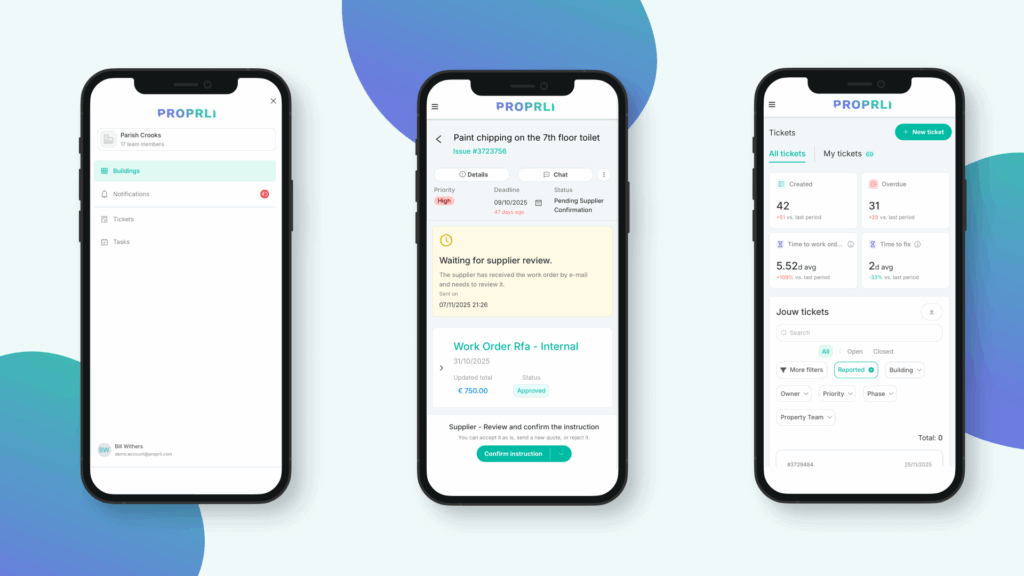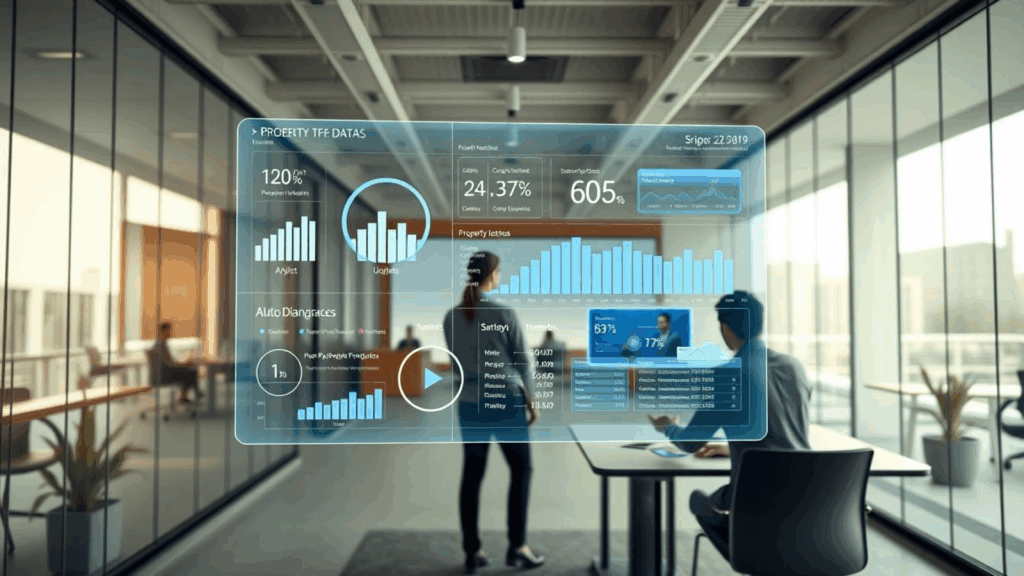Efficient property maintenance is crucial for the smooth operation of commercial offices and industrial facilities. Property managers face the challenge of optimizing maintenance processes, reducing downtime, and ensuring compliance. The traditional methods, based on manual work orders and paper-based documentation, are outdated and inefficient.
With properties becoming more complex, having multiple equipment and systems, a more streamlined approach is necessary. An integrated maintenance management system offers a solution. It uses advanced technology and automation to help real estate maintenance teams manage assets better, streamline workflows, and improve overall property management processes.
By adopting an integrated maintenance management system, property managers can enhance efficiency, lower maintenance costs, and optimize asset management. These systems centralize data, automate tasks, and provide real-time insights. This transformation revolutionizes real estate maintenance, leading to higher tenant satisfaction, increased operational efficiency, and substantial cost reduction.
Key Takeaways
- Integrated maintenance management systems streamline real estate maintenance processes
- Automation and centralized data management boost efficiency and reduce costs
- Traditional paper-based maintenance methods are no longer sufficient for modern facilities
- Implementing an integrated system enhances asset management and compliance
- Property managers benefit from improved tenant satisfaction and operational efficiency
The Importance of Efficient Property Maintenance
Efficient property maintenance is vital for the smooth operation of commercial offices and industrial facilities. It ensures tenant satisfaction, preserves asset value, and boosts operational efficiency. Regular upkeep of building systems, equipment, and amenities prevents unexpected breakdowns and extends the lifespan of valuable assets.
Neglecting property maintenance can cause equipment failures, increased downtime, and higher repair costs. Malfunctioning HVAC, plumbing, or electrical components disrupts tenant operations and harms productivity. Poorly maintained properties also have lower occupancy rates and lower rental prices, impacting financial performance.
Implementing efficient maintenance processes optimizes resources, reduces costs, and maintains a competitive edge. Proactive maintenance and preventive programs minimize costly repairs and replacements. This approach saves money and shows a commitment to quality facilities for tenants.
- Regularly inspect and maintain building systems and equipment
- Respond promptly to tenant maintenance requests
- Implement preventive maintenance programs to minimize downtime
- Utilize technology to streamline maintenance processes and improve efficiency
Efficient property maintenance boosts tenant satisfaction. Well-maintained common areas, functional equipment, and quick maintenance responses lead to lease renewals and positive recommendations. Positive experiences contribute to higher retention rates, stable occupancy, and a strong reputation.
| Maintenance Aspect | Impact on Property Performance |
|---|---|
| Regular inspections and repairs | Prevents equipment failures and extends asset lifespan |
| Prompt response to tenant requests | Enhances tenant satisfaction and increases retention rates |
| Preventive maintenance programs | Minimizes downtime and reduces repair costs |
| Technology-driven maintenance processes | Improves efficiency and optimizes resource allocation |
In today’s competitive real estate market, efficient property maintenance is essential. By focusing on maintenance and using the right tools, property managers can ensure long-term success and profitability. They also provide exceptional experiences for their tenants.
Traditional Approach to Property Maintenance and Its Drawbacks
The traditional method of property maintenance relies heavily on manual work orders and paper-based documentation. This approach often results in inefficiencies and a higher risk of human error. Property managers and maintenance teams face challenges with the cumbersome paperwork. This can lead to delayed repairs, missed maintenance tasks, and difficulty in tracking asset history.
The manual process of generating work orders, assigning tasks, and tracking progress is time-consuming and prone to miscommunication. Without a centralized system, important information may be overlooked, leading to duplicated efforts and a lack of real-time data access. This fragmented approach makes it difficult to make informed decisions and respond promptly to maintenance needs.
As properties become more complex, with multiple equipment and systems requiring regular maintenance, the traditional approach falls short. The lack of automation and digital tools makes it challenging to prioritize tasks, allocate resources effectively, and ensure compliance with regulations and standards.
| Traditional Approach | Drawbacks |
|---|---|
| Manual work orders | Time-consuming and prone to errors |
| Paper-based documentation | Difficulty in tracking asset history and accessing real-time data |
| Fragmented communication | Duplicated efforts and missed maintenance tasks |
| Lack of automation | Inefficiencies in prioritizing tasks and allocating resources |
The inefficiencies and limitations of the traditional approach to property maintenance can lead to increased costs, reduced tenant satisfaction, and potential safety risks. As the real estate industry evolves, it becomes evident that a more streamlined and technology-driven solution is necessary. This is to overcome these challenges and ensure the effective management of property maintenance.
Introduction to Integrated Maintenance Management Systems
An integrated maintenance management system, or CMMS, is a comprehensive software designed to streamline maintenance operations for real estate properties. It centralizes all maintenance data, automates work order management, and tracks assets and tasks in real-time. This makes it crucial for efficient property maintenance.
The system includes maintenance scheduling software, allowing managers to plan and schedule maintenance tasks. This ensures timely completion of tasks, reducing equipment failures and extending asset life.
Preventive maintenance software is a key feature of these systems. It uses historical data and asset information to create preventive maintenance schedules. This approach minimizes downtime and extends equipment lifespan, reducing costs and improving efficiency.
These systems also offer robust work order management. Managers can create, assign, and track work orders efficiently. The system provides real-time updates, enabling managers to monitor progress and make informed decisions.
Another benefit is the ability to track and manage asset lifecycles. The software maintains a detailed database of assets, including maintenance history and performance metrics. This data aids in making informed decisions about repairs and replacements, optimizing asset performance.
Cloud-based technology allows managers to access and manage data from anywhere. This flexibility enhances collaboration and enables quick responses to maintenance issues, even when managers are off-site.
Implementing an integrated maintenance management system can greatly enhance maintenance operations, reduce costs, and increase property value. The centralized data, automated processes, and real-time insights provided by these systems are essential for modern property maintenance.
Streamlining Work Order Management
Integrated maintenance management systems transform work order management by automating the entire maintenance process. Property managers can easily create, assign, and track work orders in real-time. This ensures maintenance tasks are handled promptly and efficiently. The automated workflows eliminate the need for manual paperwork, reducing the chance of work orders being overlooked.
When a work order is updated, the system automatically notifies the relevant parties. This keeps everyone informed about the work order’s progress. Property managers can track all work orders in real-time, seeing their status and technician assignment. They can access detailed information about each work order, including priority level and estimated completion time.
The system automatically assigns work orders to the most suitable technicians. This optimizes resource allocation and reduces response times. Technicians receive instant notifications on their mobile devices, ensuring they have all the necessary details to complete the task efficiently. This streamlined process eliminates the need for manual dispatching and ensures the right technician is assigned to the right job.
Integrated maintenance management systems significantly improve work order management efficiency. Property managers can quickly identify and prioritize urgent tasks. They can monitor work order progress and ensure maintenance issues are resolved promptly. This proactive approach leads to reduced downtime, improved asset performance, and enhanced tenant satisfaction.
The systems’ centralized database stores all work order-related information. This includes completion dates, technician notes, and associated costs. Property managers can generate detailed reports and analyze maintenance trends. By identifying recurring issues and implementing preventive maintenance, they can proactively address problems before they escalate. This results in cost savings and improved operational efficiency.
In summary, integrated maintenance management systems empower property managers to efficiently manage maintenance tasks. They minimize downtime and ensure a well-maintained property. By automating workflows, enabling real-time tracking, and optimizing technician assignment, these systems revolutionize property maintenance. They lead to enhanced productivity, reduced costs, and improved tenant satisfaction.
Efficient Asset Management with Integrated Maintenance Management Systems
Integrated maintenance management systems are transforming how property managers manage assets. These systems offer a detailed view of all assets, including their location, status, and maintenance history. This centralization allows managers to quickly spot assets needing attention, reducing the chance of equipment failure and costly downtime.
One major advantage of these systems is their ability to track assets from start to finish. They record all important details from the moment an asset is acquired, like purchase date and warranty information. As assets undergo maintenance and repairs, these events are logged, creating a comprehensive maintenance history.
Such detailed tracking aids managers in making informed decisions about asset replacement and resource allocation. By analyzing an asset’s maintenance history and performance, managers can decide when it’s more cost-effective to replace rather than repair. This proactive approach optimizes budgets and ensures properties have reliable, efficient equipment.
Advanced systems also offer predictive maintenance capabilities. Using data analytics and machine learning, they can spot potential issues before they become major problems. This proactive monitoring helps managers stay ahead, reducing disruptions and extending the life of critical assets.
| Asset Management Feature | Benefit |
|---|---|
| Centralized asset database | Easy access to asset information and maintenance history |
| Asset tracking | Monitor asset location, status, and lifecycle events |
| Predictive maintenance | Identify potential issues before they occur, reducing downtime |
| Data-driven decision making | Optimize asset replacement and resource allocation based on performance metrics |
Adopting an integrated maintenance management system with advanced asset management capabilities empowers property managers. It streamlines operations, cuts costs, and boosts property value. By harnessing technology and data insights, managers can maintain assets efficiently, ensuring they are reliable and perform at their best.
Enhancing Compliance Management
Integrated maintenance management systems are vital for property managers to adhere to government regulations and industry standards. They streamline compliance management, ensuring maintenance tasks meet regulatory needs. This makes it simpler for managers to comply and avoid penalties.
These systems automate record-keeping and generate digital documentation. This creates a detailed audit trail accessible for review. With a few clicks, managers can produce compliance reports, showing their commitment to safety and property maintenance.
Using an integrated maintenance management system streamlines compliance efforts. It saves time and reduces error risks. This approach helps avoid costly penalties and ensures a safe environment for all. It also enhances the property manager’s reputation and trust with stakeholders.
| Compliance Management Feature | Benefit |
|---|---|
| Automated Maintenance Scheduling | Ensures timely completion of required maintenance tasks |
| Digital Documentation | Creates a comprehensive audit trail for easy reporting |
| Regulatory Requirement Tracking | Helps property managers stay up-to-date with changing standards |
| Compliance Reporting | Simplifies the process of demonstrating adherence to regulations |
In summary, integrated maintenance management systems are a key tool for real estate compliance. They automate processes, create digital audit trails, and simplify reporting. This helps property managers maintain a safe, compliant environment while safeguarding their reputation and financial health.
Accessibility and Integration Advantages
Integrated maintenance management systems stand out due to their cloud-based platform. This offers unmatched accessibility and convenience. Property managers can access vital maintenance data, work orders, and asset information from anywhere, at any time, with just an internet connection. This mobile accessibility allows property managers to make informed decisions on the go, respond to emergencies quickly, and ensure maintenance tasks are completed efficiently.
Another key benefit is their seamless software integration capabilities. These systems can connect effortlessly with other essential software tools in real estate management. This includes property management software, financial systems, and even Internet of Things (IoT) devices. This integration eliminates the need for manual data entry, reducing errors and improving data accuracy. By consolidating data from various sources into one platform, property managers gain a comprehensive view of their maintenance operations. This enables them to make data-driven decisions and optimize their processes.
| Traditional Maintenance Management | Integrated Maintenance Management |
|---|---|
| Limited accessibility | Cloud-based platform for mobile accessibility |
| Manual data entry and siloed systems | Seamless software integration for improved data accuracy |
| Reactive maintenance approach | Proactive maintenance enabled by real-time data access |
The mobile accessibility and software integration features of integrated maintenance management systems transform how property managers handle maintenance tasks. With real-time data access and the ability to streamline processes through integration, property managers can move from a reactive to a proactive maintenance approach. This shift enhances maintenance operation efficiency, extends asset lifespan, reduces maintenance costs, and boosts tenant satisfaction.
Implementing an Integrated Maintenance Management System
Choosing to implement an integrated maintenance management system is a strategic move. It demands careful planning and execution. Real estate companies must first identify their specific needs and goals. This step helps pinpoint pain points and the features they require. A detailed evaluation is crucial for selecting the right technology vendor.
The vendor selection process is pivotal. Real estate companies should look at the vendor’s industry knowledge, customer support, and customization capabilities. A vendor that fits these criteria can ensure a smooth implementation and long-term success.
After choosing a vendor, training all users is the next essential step. Proper training equips employees with the skills to use the system effectively. It’s also important to implement change management strategies. These strategies help reduce disruptions and promote a positive view of the new system.
To fully benefit from the integrated maintenance management system, real estate companies should regularly assess and enhance its performance. Feedback from users and analysis of key performance indicators are key. They help identify areas for improvement and ensure the system meets evolving needs.
- Assess specific needs and objectives
- Select the right technology vendor
- Provide comprehensive training
- Employ change management strategies
- Continuously evaluate and improve system performance
By adhering to these best practices, real estate companies can streamline their maintenance operations. This leads to increased efficiency and unlocks the system’s full potential.
Case Studies: Real Estate Companies Benefiting from Integrated Maintenance Management Systems
Real estate companies from different sectors have seen great success with integrated maintenance management systems. These systems have streamlined operations, cut down on maintenance costs, and boosted tenant satisfaction. By looking at these success stories, we can understand the real value and improvements these systems bring.
A commercial property management firm, managing a large portfolio of office buildings, saw a 50% drop in work order processing time after adopting an integrated system. This efficiency allowed them to quickly respond to tenant needs, enhancing satisfaction and retention. The system also predicted maintenance needs, preventing issues and extending asset life.
A retail property owner, overseeing several shopping centers, saw a 25% boost in asset uptime with an integrated system. The system’s asset database and real-time monitoring helped schedule maintenance effectively. This led to fewer breakdowns, lower costs, and better efficiency.
| Company Type | Key Benefit | Improvement |
|---|---|---|
| Commercial Property Management Firm | Reduced Work Order Processing Time | 50% |
| Retail Property Owner | Increased Asset Uptime | 25% |
These examples show the significant impact of integrated maintenance management systems in real estate. They streamline processes, optimize resources, and use data to improve operations. As more companies adopt these systems, the benefits grow, setting new standards for property maintenance excellence.
Best Practices for Maximizing the Value of an Integrated Maintenance Management System
To maximize the value of an integrated maintenance management system, property managers must follow best practices. Regularly reviewing and analyzing maintenance data is key. This helps identify trends and make informed decisions. It also allows for the fine-tuning of maintenance schedules for better results.
Encouraging employee engagement is vital. By seeking feedback from staff, managers can pinpoint areas for improvement. This ensures the system is used to its maximum potential. A continuous improvement mindset keeps organizations ahead of the curve.
Clear processes and guidelines for using the system are essential. Promoting consistency and accuracy in data entry and maintenance execution is crucial. This makes the system a reliable tool for streamlining operations and improving property performance.
To further enhance the value of an integrated maintenance management system, consider these best practices:
- Regularly train staff on system updates and new features
- Establish key performance indicators (KPIs) to measure system effectiveness
- Conduct periodic system audits to identify and address any inefficiencies
- Collaborate with other departments to ensure seamless integration and communication
| Best Practice | Benefit |
|---|---|
| Regular data analysis | Identifies trends and enables data-driven decisions |
| Employee engagement | Ensures effective system use and identifies improvement areas |
| Clear processes and guidelines | Promotes consistency and accuracy in data entry and maintenance execution |
| Continuous improvement | Keeps organizations ahead of the curve and adaptable to change |
By focusing on these best practices, property managers can enhance the value of their integrated maintenance management system. This leads to improved efficiency, better property performance, and greater success in the competitive real estate market.
The Future of Property Maintenance with Integrated Maintenance Management Systems
Technology’s advancement is set to revolutionize property maintenance. Integrated maintenance management systems will be key, using advanced tech to enhance efficiency in real estate upkeep.
The rise of IoT devices is a significant trend. Smart sensors and connected equipment will enable real-time monitoring of assets. This will give property managers crucial insights, allowing for proactive maintenance and timely interventions.
Artificial intelligence and machine learning will also be crucial. AI will analyze data to predict maintenance needs, optimizing schedules. This predictive approach will help prevent issues, reducing downtime and extending asset life.
Cloud-based platforms will evolve, offering better scalability, security, and collaboration. They will facilitate smooth communication and data sharing, enhancing maintenance efficiency.
Advanced systems will give property managers new capabilities. These include automated work order generation, intelligent scheduling, and real-time tracking. They will also integrate with building automation systems and offer mobile accessibility.
The future of property maintenance is about using technology to achieve real benefits. By adopting integrated systems and staying tech-savvy, managers can:
| Benefit | Description |
|---|---|
| Reduce maintenance costs | Optimize resource utilization and minimize unnecessary repairs |
| Improve tenant satisfaction | Ensure prompt and efficient maintenance services |
| Enhance asset longevity | Implement proactive maintenance strategies to extend asset life spans |
| Boost operational efficiency | Streamline maintenance processes and reduce manual interventions |
As the real estate industry evolves, integrated maintenance systems will become essential. They will help managers stay competitive and deliver value. By embracing these technologies, managers can thrive in the future of property maintenance.
Conclusion
Integrated maintenance management systems are transforming real estate maintenance, offering a complete solution for better operations and efficiency. They automate work order management, optimize asset tracking, improve compliance, and offer accessibility and integration benefits. These systems empower property managers to overcome traditional maintenance limitations, gaining a competitive edge in the market.
Implementing these systems requires careful planning, vendor selection, training, and change management. However, the benefits are significant. Real estate companies that adopt these systems can see major cost savings, improved tenant satisfaction, and optimized maintenance processes. As technology evolves, these systems will continue to shape property maintenance’s future, driving success in the real estate sector.
Real estate professionals can enhance their operations, extend asset life, ensure compliance, and deliver exceptional tenant service by embracing integrated maintenance management systems. The future of property maintenance hinges on leveraging these innovative tools. This will help them stay competitive and deliver outstanding value to all stakeholders.
FAQ
What is an integrated maintenance management system?
An integrated maintenance management system, or CMMS, is a software solution for streamlining maintenance. It centralizes data, automates work orders, and tracks assets and tasks in real-time.
How does an integrated maintenance management system improve work order management?
It automates the maintenance workflow, making work order management more efficient. Property managers can track work orders in real-time and receive automatic notifications. This leads to faster response times and less downtime.
What are the benefits of efficient asset management with an integrated maintenance management system?
It provides a detailed overview of assets, including their status and maintenance history. This helps identify which assets need maintenance, reducing downtime. Advanced systems use data analytics for predictive maintenance, spotting issues before they occur.
How can an integrated maintenance management system help with compliance management?
It ensures maintenance tasks meet regulatory requirements, simplifying compliance. Automated record-keeping and digital documentation provide a clear audit trail. This makes it easy to generate compliance reports and avoid penalties.
What are the accessibility and integration advantages of cloud-based integrated maintenance management systems?
Cloud-based systems are accessible from anywhere with internet. They allow for on-the-go decision-making and faster response times. They also integrate with other software and systems, improving data accuracy.
What should be considered when implementing an integrated maintenance management system?
Planning and execution are key. Assess your needs and objectives first. Choose a vendor based on scalability, user-friendliness, and integration capabilities. Proper training and change management strategies are crucial for a smooth transition.
What are some best practices for maximizing the value of an integrated maintenance management system?
Regularly review and analyze maintenance data to optimize schedules and make informed decisions. Encourage employee feedback to ensure the system is used effectively. Establish clear processes and guidelines for data entry and maintenance execution. Stay updated with system updates and new features to continuously improve.
How will the future of property maintenance be influenced by integrated maintenance management systems?
Advancements in these systems and related technologies will shape the future of property maintenance. Increased integration with IoT devices and AI will enable real-time monitoring and predictive maintenance. These technologies will make maintenance systems even more powerful, streamlining operations and driving efficiency.






